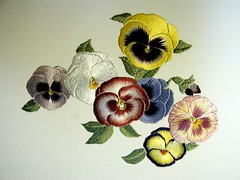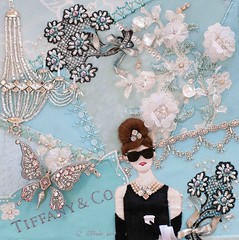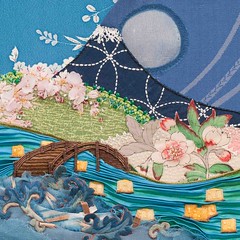My
Hearts and Hands for Sendai quilt block is finished -- ready to head off on its journey and become part of a larger quilt to benefit Sendai, Japan.
You'll have to forgive me now because I'm going to get a little deep. It happens sometimes when I've spent many hours with a project that comes from my heart. Don't say I didn't warn you.
I believe that embroidery is a spiritual exercise.
I believe that great love and energy has been generated by every person who picked up a needle and made a block for one of these quilts.
I believe in the power of your energy as you read this blog post and bear witness to its message.
I believe that all that power...the power of all those communal stitches and thoughts...has, indeed, already helped someone in some way.
I never underestimate the power of human connection...the power of us. And the power of our hearts and hands to help Japan.
I had the good fortune of living in Japan for close to three years in the early '90s and feel a strong connection to the land and the people. I enjoyed all of the many festivals that occurred in my local village and tried to participate in as many as I could. But one of my absolute favorites was the ceremony of Toro Nagashi at the end of O-bon.
O-bon is a festival that honors the spirits of deceased ancestors.
O-bon occurs in either July or August and lasts for three days. On the last day, there is a lantern lighting ceremony called
Toro Nagashi where floating lanterns are lit and released into a river in order to guide the spirits of the departed to their afterlife.
I remember the mood being fairly somber as families wound their way through the streets down to the river bank...many of the young children dressed in kimono.
Just seeing all of those lit lanterns making their way downriver...
Well. It's quite a beautiful sight.
And you definitely feel a profound sense of honor and respect for those who have left this earth.
I knew I wanted to include those lit lanterns on my river in this quilt block -- to honor the thousands and thousands of lives that were lost.
And Mt. Fuji as Japan's most sacred mountain...and symbol of national pride...
And the moon reminding us of the passage of time. That Japan has existed for a very long time, through countless lunar cycles, through countless disasters, and will continue to persevere through countless more.
The bridge...connecting...
Connecting one state of existence with another. Connecting the losses of the past to hope for a brighter tomorrow. Connecting all those whose lives were lost to their afterlife.
And I tried to use Japanese textiles...kimono silks, sashiko quilting, and shibori...to remind us of the great strength and beauty and resourcefulness within Japan.
Made by my hand in the West, sending great love and hope to my friends in the East.
If you are interested in making a financial contribution as part of our fundraising/quilting effort, visit
this post to see how you can donate.
I'm heading to New York city with Jack for the day tomorrow but when I come back on Tuesday, I'll try to put together a few Japanese fabric packs for sale...all proceeds to go to Sendai.
See you then.
Past Posts about this block:











































































